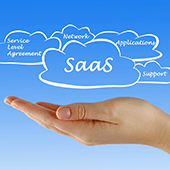
What is SaaS and what makes it appealing?
SaaS is a software delivery model that allows the user to access software from any device via the internet. This gives you more flexibility since you don’t have to come to the office to use the software. You can work from anywhere as long as you can go online.
As opposed to a traditional on-premises setup where software is stored locally, SaaS is hosted in the cloud. By transferring software hosting to a third party, you’re outsourcing all the responsibilities that come with maintenance, such as upgrades and troubleshooting. In a way, getting SaaS is like renting a car: Somebody else owns the vehicle, but you get to drive it.
Shifting software ownership away from your business also changes how much you pay for it. With on-premises software, you purchase a license and pay yearly support fees, which can amount to 22 percent of the price of license fees (ouch!). With SaaS, you pay a monthly or annual subscription fee that covers licenses, support, and other fees. This is better since it allows you to spread out costs on a monthly basis, instead of purchasing expensive licenses outright and ending up with a huge maintenance bill every year.
Will my data be safe?
One of the issues that make companies reluctant to switch to SaaS is data security. Who will own my data? Will my data be safe? What if the vendor goes out of business?
For your peace of mind and safety, when you’re outsourcing your software to a SaaS vendor, you have to sign a service level agreement (SLA). This should specify that you own the data and that the vendor is obliged to provide access to your data even if it goes bankrupt.
Data hosted by your SaaS vendor will be more secure than when it’s stored on your average SMB’s network. That’s because SaaS vendors have to undergo strict security audits, forcing them to invest more in security, backup technology, and maintenance than a typical SMB.
Should I switch to SaaS or stick to on-premises?
SaaS is an ideal solution for small and medium-sized businesses that are looking for a way to reduce upfront costs. But if your business is large or has complex processes, a traditional on-premises solution might be better since it offers more functionality and allows for full customization.
Still unsure about whether SaaS is the right answer for your organization? Want to know more about SaaS before making the transition? Call us today! Our experts are ready to answer any questions you may have about SaaS.
You must be logged in to post a comment.